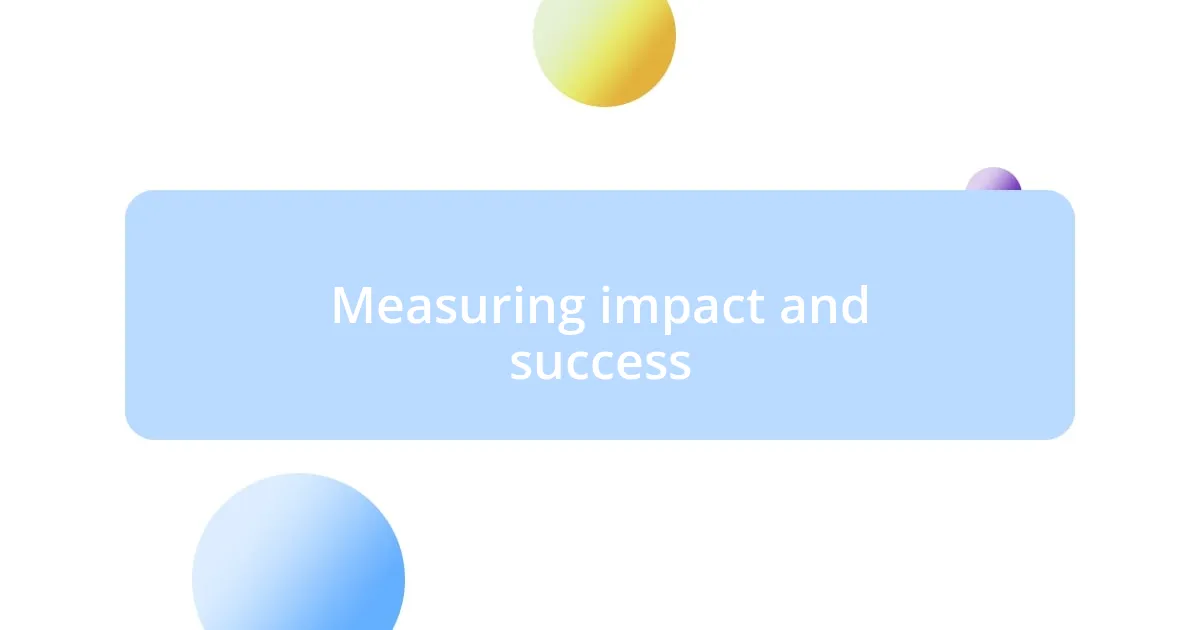Key takeaways:
- Community gardens enhance mental well-being, foster relationships, and promote sustainability through local food exchange.
- Key factors for a successful garden include accessibility, sunlight, soil quality, and community input when choosing a location.
- Engaging volunteers through shared experiences and recognizing local talents fosters a sense of ownership and connection within the community.
- Tracking garden success can be accomplished through harvest results, community engagement, and educational workshops, reflecting both growth and impact.

Understanding community gardens benefits
Community gardens offer an incredible opportunity to foster connections among neighbors. I vividly remember one summer in my local garden when strangers became friends while sharing gardening tips and stories over a shared plot. Have you ever experienced that sense of community that blossoms from a simple seed?
Beyond just building relationships, these gardens enhance mental well-being. There was a time when I felt overwhelmed with life’s pressures, and spending time digging in the dirt was a soothing escape. There’s something cathartic about nurturing a plant, not to mention the satisfaction of seeing it thrive. Aren’t you curious how engaging with nature can refresh your perspective?
Moreover, community gardens naturally promote sustainability. I’ve observed firsthand how exchanging produce among local gardeners sparks creativity in the kitchen. Imagine cooking meals with ingredients grown right in your neighborhood! Isn’t it fascinating how these gardens contribute to a more self-reliant community, reducing our carbon footprints while fostering a sense of pride in our local environment?

Choosing the right location
When selecting the right location for a community garden, I’ve found that accessibility is key. A site close to public transport or with ample parking can significantly increase participation. I once saw a community struggle because their garden was tucked away, making it a hassle for people to visit regularly. It’s all about creating an inviting space where everyone feels welcome.
Here are some important factors to consider:
- Sunlight: Look for areas that receive at least six hours of direct sunlight each day, as this is crucial for plant growth.
- Soil Quality: Testing the soil beforehand can determine if it’s suitable for planting; poor soil may require amendment.
- Water Supply: Access to water is essential; nearby spigots or a rainwater collection system can be a game changer.
- Community Input: Gathering opinions from potential gardeners ensures the chosen spot meets everyone’s needs.
- Safety: Assess the safety of the area; it’s vital that everyone feels secure while cultivating their plots.

Designing a successful layout
Designing a garden layout is like crafting a masterpiece; it demands both creativity and functionality. In my experience, I learned that starting with a clear plan can make all the difference. For instance, during one project, I got so caught up in enthusiasm that I neglected to leave enough walking paths, causing folks to accidentally trample delicate seedlings. Have you ever seen chaos arise from a lack of foresight in planning?
Another important aspect is grouping plants based on their compatibility. I remember experimenting with companion planting in one of my gardens, where herbs like basil flourished alongside tomatoes. Seeing the plants thrive in harmony was incredibly rewarding. It’s not just about aesthetics; it’s about promoting plant health and maximizing space.
Additionally, incorporating communal spaces within the garden layout encourages social interaction. I once visited a garden designed with a central gathering area for workshops and meetings. The atmosphere was vibrant and welcoming, and I felt inspired to connect and share ideas with other gardeners. Don’t you agree that creating spaces for gathering can enhance the community spirit?
| Layout Element | Considerations |
|---|---|
| Plant Arrangement | Group compatible plants for healthier growth. |
| Walking Paths | Ensure adequate space to avoid trampling plants. |
| Community Spaces | Include areas for social interaction and education. |

Selecting plants for community gardens
Selecting the right plants for a community garden is an adventure in itself. I’ve always found it fascinating that the choices we make can reflect the diverse tastes and needs of the community. For example, during one of my earlier gardening ventures, we decided to plant an array of vegetables and herbs. The joy of watching neighbors’ eyes light up as they discovered their favorite crops—like zucchini or cilantro—was incredibly rewarding. Isn’t it fulfilling when we can grow foods that bring people together?
Another critical consideration is understanding the local climate and seasons. I recall a summer when we planted some beautiful heirloom tomatoes too late in the season and ended up with very few ripe fruits. Watching those green tomatoes struggle to ripen was disheartening! It taught me to embrace native plants that flourish in our environment. What if we all selected plants that thrive without excessive care, promoting a sustainable and low-maintenance garden?
I’ve also seen firsthand the magic of including flowers in our plant selection. During one community garden initiative, we added sunflowers that towered over the veggies, creating a stunning visual spectacle. Not only did they attract beneficial pollinators, but they also sparked conversations among gardeners. How often do you see a beautiful bloom and feel instantly uplifted? By thoughtfully selecting a mix of edible and ornamental plants, we can create a vibrant tapestry that nurtures both our garden and our community spirit.

Engaging the community and volunteers
Volunteers are the heartbeat of any community garden, and engaging them effectively is crucial. I remember my first day volunteering; the energy was infectious as seasoned gardeners shared their tips and stories. That personal touch not only made me feel welcomed but also motivated me to contribute my best. Have you ever noticed how enthusiasm is contagious in a group? When people feel valued and involved, they’re more likely to return.
Organizing fun, hands-on events can draw in volunteers and keep spirits high. For instance, I once helped coordinate a planting day that included a barbecue and music. The laughter and camaraderie brought everyone together, transforming strangers into friends. Isn’t it amazing how shared experiences can forge connections that extend far beyond the garden bed? I found that these moments not only helped with planting but also fostered a sense of ownership in the garden.
Additionally, recognizing local talents can create a sense of pride and engagement. In one garden, a neighbor who was a skilled chef offered cooking classes using produce from our plot. This not only taught us valuable culinary skills but also showcased the fruits of our labor. Have you thought about what talents your community members could share? Integrating these unique skills into garden events deepens relationships and enhances the overall experience for everyone involved.

Sustaining and maintaining the garden
Maintaining a community garden is like nurturing a friendship—it requires consistent effort and attention. I learned this lesson the hard way after neglecting a small patch of carrots for just a week. When I finally returned, I was greeted by a tangle of weeds that had claimed their space. That experience was a wake-up call! It made me realize that a quick, regular check-in can make all the difference. Petty maintenance tasks, like weeding and mulching, turned into a meditative routine for me. Have you ever felt the calming effect of simply being present in nature?
Watering is another crucial aspect of garden upkeep. I fondly recall those hot summer days when I used to lug around a watering can, chatting with fellow gardeners about which plants were thriving. I discovered that setting up a simple drip irrigation system not only saved time but also ensured every plant got just the right amount of moisture. Isn’t it fascinating how a small change in method can yield healthier crops and save energy?
Lastly, composting became a game-changer for me. I remember my initial hesitation when the idea was first introduced—I thought, “How messy could that be?” But once I dove in, it felt so rewarding to divert kitchen scraps into a rich, nourishing soil amendment. It was like alchemy! Seeing my garden thrive from that homemade compost gave me a sense of accomplishment. What if everyone treated composting as a natural part of gardening? It’s an empowering way to close the loop on food waste while enriching our soil and plants!

Measuring impact and success
Tracking the impact and success of a community garden can sometimes feel daunting, but I’ve found it incredibly rewarding. One way to measure our progress is through the tangible results of our harvests. I remember the joy on everyone’s faces the first time we gathered enough tomatoes for a community salsa night. It wasn’t just about the quantity; it was about sharing that moment of achievement together. How do we quantify those joyful experiences, though? I believe the best metrics involve community feedback and participation rates.
Another fascinating aspect of measuring success comes from observing changes in community dynamics. I’ve noticed that as more people engaged, friendships blossomed, and collaboration flourished. During one season, we even coordinated a garden swap where excess produce was exchanged amongst neighbors. Have you considered how these interactions can weave a tighter community fabric? I cherish how such events create a sense of belonging and encourage active participation, leading to even greater success in subsequent seasons.
Lastly, I’ve found that assessing educational outcomes is a powerful indicator of impact. When we initiated workshops on sustainable gardening practices, attendance and engagement revealed our success. I recall how participants would leave brimming with excitement, sharing their new insights and plans for home gardens. Isn’t it heartening to see someone’s enthusiasm grow alongside their plants? By tracking attendance and the knowledge gained, we gauge not just the skills acquired but also the ripple effect they create within the broader community.












